Gigabyte's i-RAM: Affordable Solid State Storage
by Anand Lal Shimpi on July 25, 2005 3:50 PM EST- Posted in
- Storage
Using the i-RAM
To begin our testing, we loaded up the i-RAM with four 1GB DDR400 sticks. We didn't have any large DDR200 modules, so unfortunately we had to go with more modern DDR400. Using DDR500, DDR400 or DDR200 doesn't change performance at all, since the Xilinx controller runs them all at the same frequency.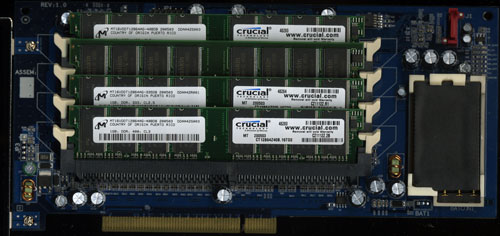
Powering the system on revealed the installation was a success; the BIOS reported the presence of the i-RAM as a regular storage device connected to our SATA controller:

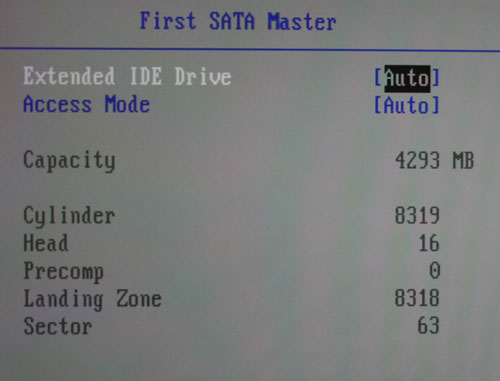
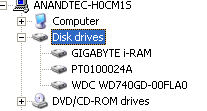
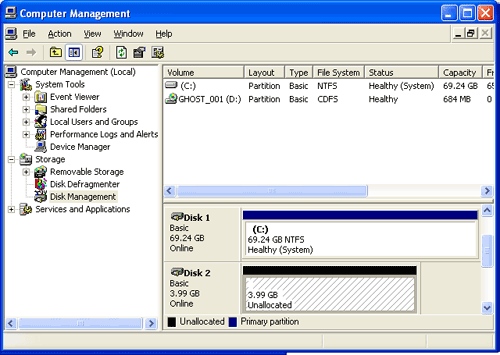
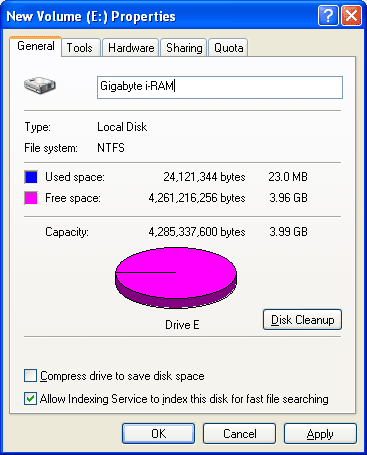
Also, all disk accesses are instantaneous; formatting the thing takes no time at all, and you can even "defragment" it (although, you get no benefit from doing so).
With the setup done, it was time to evaluate the i-RAM as more than just a novelty silent hard drive. Armed with our 4GB partition, we started testing...
The Test
We ran all of our tests on the following testbed unless otherwise noted:ASUS A8N SLI Deluxe nForce4 SLI Motherboard
AMD Athlon 64 FX-57 Processor
1 GB OCZ 2:2:2:7 DDR400 RAM
Seagate 7200.7 120 GB Hard Drive (boot drive)
Western Digital Raptor W740GD (test drive)
Gigabyte i-RAM w/ 4x1GB DDR400 modules (test drive)
We used the latest nForce 6.53 and ForceWare 77.72 drivers for our test bed, and paired it with the recently released GeForce 7800 GTX.










133 Comments
View All Comments
NStriker - Thursday, July 28, 2005 - link
Anand quotes $90 per GB of RAM here, but I'm wondering if the I-Ram works with the much cheaper high-density junk you see out there all the time. Like 128Mx4 modules. On motherboards, usually only SiS chipsets can handle that type of RAM, but there's no reason the Xilinx FPGA couldn't.Right now I'm seeing 1GB of that stuff for $63.
jonsin - Thursday, July 28, 2005 - link
Since Athlon64 north bridge no need the memory controller. Why shouldn't the original memory controller used for iRam purpose. By supporting both SDRam and DDR Ram, people can make use of their old RAM (which no longer useful nowadays) and make it as Physical Ram Drive.Spare some space for additional DDR module slot on motherboard exclusively for iRam, and additional daughter card can be added for even more Slots.
Would it be a cheaper solution for iRam ultimately ?
jonsin - Thursday, July 28, 2005 - link
And more, power can be directly drive from ATA power in motherboard. By implementing similar approach to iRam, an extra battery can power the ram for certain hours.By enabling north bridge to be DDR/SDRam capability is not a new technology, every chipset compnay have such tech. They can just stick the original memory controller with lower performance (DDR200, so more moudle can be supported and lower cost) to north bridge, the cost overhead is relatively small.
What I think the extra cost comes from extra motherboard layout, north bridge die size, chipset packaging cost (more pins). I suppose it can cost as low as $20 ?
jonsin - Thursday, July 28, 2005 - link
More, the original SATA physical link can be omitted as the controller in North Bridge can communicate directory to SATA controller internally (South bridge thru HT ?) In this case, would the performance increate considerably and the overall layout more tidy ? (no need external cable and cards)mindless1 - Friday, July 29, 2005 - link
NO these are all problems. The purpose is to have a universal platform support that is gentle on power consumption. That means a tailored controller and even then we're seeing the main limit is the battery. "Tidy" is an unimportant human desire, particularly less important inside a closed PC case. All they have to do is route bus traces well on the card and be done.slumbuk - Wednesday, July 27, 2005 - link
HP sell an add on for their DL 380 server for $200 (at discount) that gets you 128MB of disk write cache... makes a good system also fast for disk writes.This card could be used by linux vendors to enable file-system data and control logging for similar money for GB(s) of write cache... Cheap, reliable, fast general purpose file servers.. that have fast disk write speed without risking data loss.. Speed meaning no disk-head latency, no rotational latency - just transfer time.
It would sell better with ECC memory.. or the ability to use two cards in a mirror.. at least to careful server buyers..
slumbuk - Wednesday, July 27, 2005 - link
You could set up the iRam drive as the journal device for Resier or Ext-3 logged file systems - and log both control info and data - for fast, safe systems without too much fuss.I think I want one - but not as much as I want other stuff..
AtaStrumf - Wednesday, July 27, 2005 - link
Interesting but hardly useful for most. Kind of makes sense to only make 1000, but of course that's where the $150 price tag comes from.rbabiak - Wednesday, July 27, 2005 - link
i guess it would add to the base board cost, but a SATA controller on the PCI card would make it a littl nicer as then you are not takeing up one of your SATA channels, i only have 2 and they are current both used for a Raid-0Also if they made the PCI card a SATA interface and then short circeted the backend to conect directly to the memory, wouldn't they then be able to get much higher transfer speeds than sata and yet all the existint SATA divers could be used with it, given they emulate a existing SATA interface.
DerekWilson - Thursday, July 28, 2005 - link
Better to use the onboard ports ...a 33MHz/32bit PCI slot only grants a max of 133MB/sec. This would make the PCI bus a limiting factor to the SATA controller.
Step beyond that and remember that the PCI bus is shared among all your PCI cards. Depending on the motherboard some onboard devices can be built onto the PCI bus.
With bandwidth on current southbridge chips already being dedicated to SATA (or SATA-II), it would be a waste in more ways than one to build a SATA controller into the i-RAM.
That's my take on it anyway.
Derek Wilson